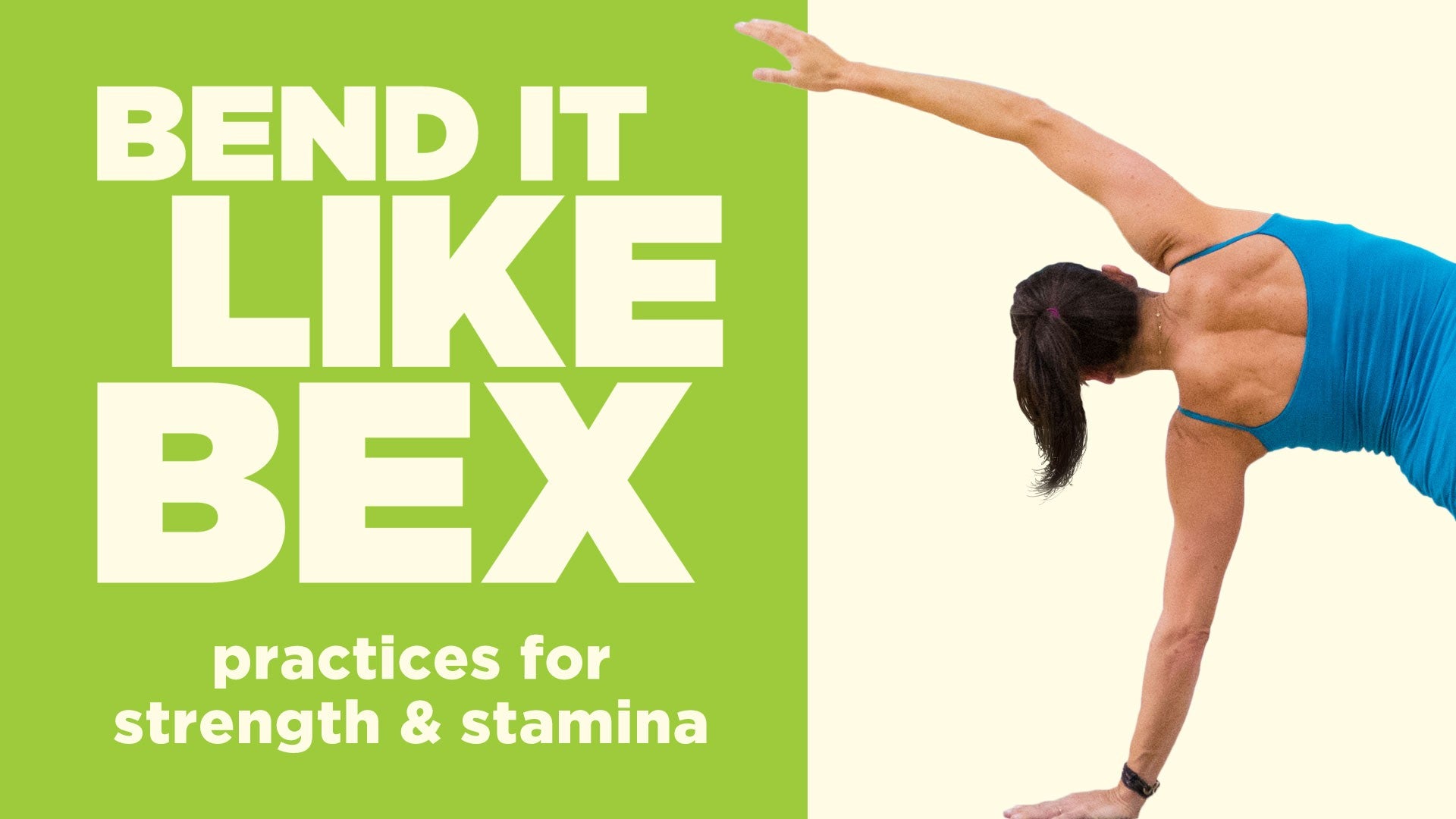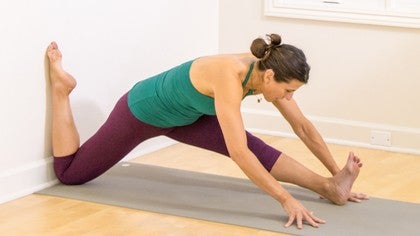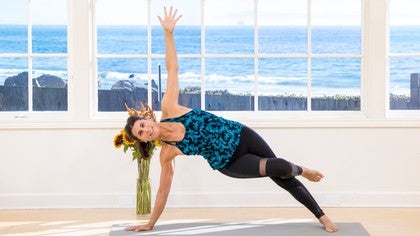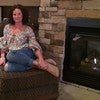Description
About This Video
Transcript
Read Full Transcript
(waves swishing) Welcome, I'm Bex, and this sequence is a collaboration with the wall and unpacking the pelvis, just a little bit of release going on. So find a comfortable seat and begin to bring your energy inward. Close your eyes and sit up real tall, and you feel the breath. And so as you sit up tall and you kind of feel the breath, wriggle out anything that needs to be released. And take your eyes, your inner gaze, all the way to the base of the spine.
It's so often for many, we shove a lot into the pelvis, or we sit a lot, or we bike, or we hike, or we run, whatever it is we do, and then we forget to love up the pelvis. So just gaze there. Send some energy there and breathe. And so there's an immediate response in the body when you bring the energy into the base, and into the pelvic bowl, so just, wait with the breath there, and see if as you travel into that space, you can be receptive. Sometimes if you are really connected, you can hear other stuff coming up, and, just watch your breath and watch how that stuff comes up for you.
So have a sense of willingness, willingness and the ability to let go of whatever's appropriate for you. That we hold ourself, and in that space, know that you're worthy, you're enough, whether it feels like your pelvis is your area of release or resistance, just be with it. So if you've sort of uncovered a space that you wanna sit with longer, feel free to sit here longer, and just be absorbed in it. Otherwise, bring your hands to your heart center in prayer, and set that intention, that dedication, that mantra, that motivation, and maybe the mantra is, I am releasing, I am willing. Right, whatever feels right for you, be true to that.
And then draw the chin to the chest, right, may your practice benefit all the people around you. And then slowly open your eyes. So, we'll begin on all fours, and as you come onto all fours, you can close your eyes again. You're just willing yourself into that space, and, I find for me, if my thigh bones windshield wipe, I'm always very clear about the space on the side of my pelvis, all the way down to the side of my knees that could use just a little bit more attention. So, if that works for you and you go to the side and you think, wow, I don't ever get into that nook or cranny, spend some time there.
And if that allows you more permission to kinda swivel and loop in the body, go ahead and do that. So it's a bit of free-flowing movement, because we're delicate with how we approach the pelvis and what's ready to unpack, I promise you. If something comes up, and you're not ready, right, it's sort of like Gremlins, it'll show up two times. You don't wanna overdo, so you just kinda feel that space within, and let yourself know whatever you're ready to let go of, whatever you're ready to give yourself permission, it'll happen. Doesn't have one way that it looks, so, just round the back, and arch the back.
Right, if you're more familiar with cat, cow, dog, whatever works. After a couple of those, I'm gonna invite you to do what I call jump-roping. So the torso kinda feels that flow of a jump rope, and the ends of the jump rope, if you haven't figured it out, are the pillars of the arms and the columns of the legs, and you just kinda let it go around. So you're easing your way in, because easing your way in allows for a little bit more unraveling, and that's where the body actually kind of delights in the comfort. Now, find your way into adho mukha svanasana, downward facing dog.
And since you have the benefit of the wall, take your heels up. And you can take your heels up high, like you're wearing high heels, stilettos, or you can take them just a little bit up. A little, I think they're called kitten heels, I've just learned that term, so I'm sharing it with you. Not that I own any, but anyway. So you come into down dog and you breathe.
And you feel that middle point, right, that connection point. The torso, and the legs, oh yeah. There you are in your pelvis. So slide the feet into the wall, little traction in the legs, inhale to the plank. If you need a child's pose, you go there.
If not, here you are, chaturanga welcomes you. Low cobra, up dog, and downward facing dog. So remember not to take yourself so seriously in a practice where you are unpacking. Right, it can get a little messy. And sometimes the messier it is, the more you can welcome it.
Inhale, again, plank. Exhale, inhale, breathing, moving meditation. That's where you go. Right, anytime, anytime, anytime you need child's pose. Invigorate the arms, feel the hands, forearms, upper arms, shoulder girdle.
Head. Plank, feet connect with wall, chaturanga, low cobra. Down. And then, as you're in down dog, just be still here. If you want a child's pose, right, you just lower the knees, and let the hips and the heels meet, and the forehead come to the mat.
Down dog. So as we move through here, you will step the right foot forward. The back heel will go to the wall, as much as it can, and the knee will land. And I can feel that my Achilles, that nice tendon there, is pulling my heel off the wall, and I'm okay with it. If I really wanted to, I could pad it, for more feedback.
But you will sit into this low lunge, and just keep your hands on your pelvis. You're kinda like, just giving them a little hug, to let them know stuff's gonna happen here. And you wait. And then see if the pelvis will descend a little. Now place the hands on the mat, down dog, and simply switch legs.
So back heel into the wall, best that it can be, and then hands on the hips. Inhale, press, lift. So there's this midline merging that happens, and there's a sprouting that comes up from there. And again, I'm just kinda giving myself a little bit of that hug in. Hands down, down dog.
Okay, this time when you step the right foot forward, just to feel something different, the back toes will press the toenails into the floor, and you will keep the hands on the hips and then inhale. And you might be able to get a little bit more of a back bend out of this, knowing that your pelvis feels like it's drawn down, just as the ribs are rising up. And then the hands come down, and you repeat that on the other side. So, the left foot steps, the top of the right foot connects, you see if you can diminish the space between the shin bones and the mat, so that that gives you a pushing point, because it's gonna show up later. And so without future tripping, without getting ahead of ourselves, we're just planning a little bit in the legs.
Hands down, down dog. This time again, foot to the wall, knee down, and now just easy, very gentle, very gentle, left elbow on right thigh. And I like to put my hand into a fist and just slowly ease my way into the twist. There might be more space here, but it's still early, and I know there are more twists to come, so I'm just sort of nibbling at this twist. Hands down.
Step back, down dog. Left foot, right knee down, heel in the direction of the wall. And then again, I just take that twist there, and in that space, I'm lighting up my inner thighs. I'm lighting up my inner thighs, and that helps me feel my low belly kinda draw inward toward the front of my spine. Hands down, down dog.
So you'll feel that even more deeply as we go into the lunges, the higher ones. Step the right foot forward, slide that left heel into the wall. Right shin bone's working toward upright, thigh bone parallel to the floor, and then inhale the arms up. So as the arms come up, there's a generous amount of effort in the back leg, and it really feels wonderful for the front of the left thigh. So you sit into that, and let the arm bones kinda slide into their happy place.
Head moves back, no tension, and then hands thread through heart center. Arms come down, vinyasa if you like, or avoid it, chaturanga. Inhale, up, exhale back. Left foot steps. Again, you might need to slide the right leg back.
You tune in, right, there's like this energy that happens when you feel that connection and then you rise. And you breathe, and there's little spaces, micro-movements, that bring you in, and that's where you listen. And the hands come down, cycle through. Vinyasa, exhaling, inhaling, exhaling. And what I find interesting, step the right foot forward, left heel pressing into that wall, it's really giving you some energy.
As you twist the left elbow, again you can fist here, in that twisting alanasana, here you are. What I find interesting, is watching and listening to the mind, and hearing what you're saying to yourself. (breathing) Hands down, down dog, exhaling. Inhale, plank. And then exhale, inhale, up, exhale, back.
Left foot steps, right foot presses into the wall. Inhale and come up, and then exhale, twist. And so as you twist, you're in that inner quiet conversation. And you feel and you breathe, and as you know what you're saying to yourself, just ask yourself if you could say that to someone else. And then if you couldn't, probably worth considering eliminating that conversation.
Hands down, down dog. Plank pose. Chaturanga. Low cobra, down dog. One more here, the right foot steps, so when you inhale up, super important that you feel your feet, so that when you reach the right arm forward and the left arm back, and you're in an open twist, you'll notice maybe your fingertips can touch the wall, maybe they can't, that energy needs to be as equal as it can through the right and the left.
And then the arms come down. Down dog. Inhaling, exhale. Inhale. Exhale.
Left foot steps, again, that wonderful space that provides you with that place of stability. And you push, and you reach, and so as you're reaching, you see, can you assist yourself a little further, or are you exactly where you need to be? And you just play with that fine line of balance. And then the arms come forward and down. Down dog, and here you'll just wait in down dog, breathing.
(breathing) Right foot steps, left heel in. Now you are in warrior one, virabhadrasana one, and as you approach this, you feel like the back leg is always as strong as the front and the arms come up. If you prefer goal post arms, or wide, or together. Whatever gives you freedom there. So you sit into that space, where you lift out of as well.
It's not like there's a collapse in the ribcage, you're rising up through there. And the arms come down. Inhaling, exhaling. Left foot steps, right heel in, and you come into warrior one again, and, there's that, kinda like, I think of it like the ribs hovering over the pelvis, and as they levitate over the pelvis, the arms come back, the ears kind of come back. So that there's the wonderful feeling of filtering the ribs down, and mine tend to like, to spill forward, so that's where I have to bring some awareness, without getting hypersensitive.
Hands down, cycle through or visit child's, or hang out in plank for three rounds. Now the right foot will step, left heel will come in. Interlace the hands behind the back, so I know what's coming, and since I know what's coming, I shorten the stance, you'll shorten the stance too. The arms are behind you, the back heel now, kinda gets a little tricky cause you are almost in crescent. So you went from a warrior one with the hands behind you, to almost the heel coming off, and then you will slowly shift and lift.
And maybe your foot touches the wall, and then you use that, and then you lift. You can keep that right knee bent, or you can go for straight. Again, there's a lot of breath. Hands down, left leg lands, and then right follows. Inhaling, and exhaling.
So, right heel in, left foot steps, and that's the moment where you inhale through warrior one. The transition is to take the hands behind you. I like to switch my thumbs, come off the back heel, and then gain that sense of strength. Slide the left heel in, inhale. Shift and lift.
And that time, I really did use the wall to help lift my leg, and then I have to just be patient. Patient with myself. Can't rush the pose. Hands land, Right, and then left. Now slide the feet into the wall, and come on to the outer blade of the left foot for vashistasana.
Now, I actually like doing vashistasana at the wall, because there I am finding that place where there's a wave, and then I lift that right leg up. So that there's a little decompressing in the pelvis, like the leg gets to lengthen. And then down. You can stay there longer obviously, if you wanted. And then on to the outer blade of the right foot, and the left leg comes up.
And if you need to be on a forearm, please do so, alright? Honor your body. And then release. Back to down dog. Right leg lifts, so your right leg goes up the wall.
Your foot is flexed, you know what the flex feels like. You've been doing that through the practice, and then you will climb the hands close to the wall. Doesn't really matter how close you get, right, it's where you feel. Roll that right inner thigh toward the left one. (breathing) If you just got a pedicure, it's unfortunate here, because the knee will slide, and you'll point the toes.
You can just take those toes away from the wall, and you'll land on the knee. When the knee lands, the left foot comes forward enough that it's vertical through the lower leg and horizontal. And for those of you who have any kind of resistance through the right quads, and the hip flexors. Right now you'll just send so much love, so much love. It doesn't help to tell yourself, oh, I'm so tight in my quads, right?
You just let that breath come in. And then if that's not enough for you, you inhale your arms up, you could even bend them. Again, for me, I have to be mindful of where I'm bending, and is it worth it. So, my arms'll go up, and I'll feel something. And that helps that loop, that line, chain of energy.
And then slowly, take the left elbow outside, the right elbow outside the left knee. Right elbow outside the left knee. So breathe here. Hands come down. Now you'll slide, you will slide that left foot forward.
It might only go an inch, and you might be satisfied, right. Okay. Or it might go three inches, or you might be eager to go a little further in arda hanamanasa, half hanamanasana. And what I'm looking for inside myself, is the integrity of my pelvis. Because I could slide my left foot more forward and let my right hip trail back, but for me that doesn't feel aligned.
So I go, and if I had a block or something that I wanted to receive the back of my left leg, I could certainly do that. So just breathe here. And climb the hands forward, if that's interesting. And then you have to watch what's coming up in the pelvis, right, what are you telling yourself? This is that conversation again, and is it helping?
And if it's not helping, it's probably harming. And if it's harming, why are you having that conversation? Right, cause that's what happens in the pelvis. Whether you believe it or not. Slide the left heel in, so you'll slide the left heel in so that you can gracefully slide the right shin bones forward, and then flex the right foot.
Now this is for those of you who have been waiting for that moment for hanamanasana, right, I'm never really waiting for that moment of hanamanasana, but the back leg pushes in. And the front foot pushes away. And this is different than me just falling into it, if I could. This is a lot of work for the mound of my big toe, baby toe, and heel, as if the wall was here as well, and behind me, probably like one of those Bruce Lee films where he's pushing one foot forward and one foot back. That's the kind of sensation you want there.
You want to create that, because then there is this unpacking. Okay, then slide the left heel in, as much as you probably wanted to stay there for a little longer. And you will bend that right knee. This is one you have to be really careful with. If you have sensitivity in the knee, you can always pad underneath the left hip, or just forget this pose, right?
This pose is a runner's pose. In Sanskrit, it's called triang eka pada paschimottanasana. So it's a long one, but it just, knee is folded and you fold forward. There's a tendency to weight, meaning heavy, through the left side, so you balance the architecture of the shape and then you fold. (breathing) And, as if you can't get enough on this side, there's just one more pose.
Right, the twisted monkey. So, you'll bend that left knee again, and if you're pretty content right here, just stay right here, okay? If you feel like it's easier for you to grab the foot with your right hand and that makes you happy, that's fine too. Otherwise, you just simply sit into the pelvis. You could wait right here and breathe, that could be a lot.
Or, since we've done a lot of twisting, maybe you grab the outside edge of the right foot with the left hand and you lean and twist. Now, for me it feels a little bit more available to come onto my forearm, and I like that space, cause I have more sensation in the front of my right hip. And so I want to go there today. Not every day, but today I do. And then slowly, you come out and take child's pose, right.
And in child's pose, there will be sensations through one side that have yet to come on the other. So even here, watching the mind. Right, did you get caught up in a story, and did it serve your practice? Was it helpful? Down dog.
So you can't rush, you can't rush the pelvis. You can try, but it has its own timeline. Inhale, chaturanga, exhale. Inhale, low cobra or up, downward facing dog. (breathing) So if you're lucky, you forgot what happened on the right leg.
Cause it's all about to begin on the left. So the left leg goes up the wall. Foot is flexed, you climb up and you climb up, and you breathe. And the sensations arrive immediately. And then for me, I can hear it.
Oh, this is my tighter side. And so I just like, silence that, and breathe. This side has challenges, meet them with compassion. Left knee slides down. When the knee lands, the right foot forward, sometimes it needs a little assistance.
And then you come up. Now, if you're particularly sensitive on the top of the foot, hopefully you figured this out on the other side, you can pad the wall, okay? So, never suffering in the practice, right, never suffering. Giving yourself support. Inhale, you're in that knighted pose.
You can keep the hand on the, each thigh, or, find that place where you reach up. Right, and so the places that sort of light up for you, right, like, my front of my left thigh right now is saying, "How come we don't spend more time here?" Right, how come we don't spend more time here? And then just breathe, and watch, without expectations. Easy to think, I don't need to spend time here. You just need to release.
That comes from a bossy place. So, maybe I reach up and I go, mmm, that's interesting on this side. Little adjustments. Okay, the left elbow outside the right thigh. Hands in prayer or fisted bottom.
Hand and then twist. And you just smooth it out. (breathing) Hands come down. I like to be quiet when twisting with the pelvis because there's a lot being said inside, so just wanna listen. That's the word that just is brighter and brighter.
Listen, listen. Then slide that right heel forward an inch. Wait, breathe, when there's approval to go forward, go forward. If there's not, it's okay. More breath.
(breathing) So, in my mind, what happens is I tell myself, my breath can heal my body. My breath can support any release that my body's ready for. And then the heel slides in just enough that with both hands closer to that left leg, you can slide the left shin and foot, so the heel goes into the floor, and you can go into your beautiful variation of hanamanasana. Right, and it's, it doesn't have to be hips down for it to be a beautiful variation. Right, if that's what you consider a beautiful variation, just keep that judgment for yourself, right, not for anyone else.
For me, this is a lot of work. I'm breathing, and I'm just doing my best to accept my right hamstrings, right, that carry me when I wanna run, when I wanna hike, when I wanna bike. And if I ask them to just totally be loose for my hanamanasana, when I go on my hike, if they don't support me, I'm not going very far. So I have to appreciate where they are. After all, it's yoga, it's mindful movement.
It's not acrobatics, in case you're confused. Slide the right heel in, and then, the left knee and shin forward and you sit here. And in this variation, remember I said if you want a pad underneath that left hip on the other side, this time the right hip, you do. Really flex and have a lot of accuracy, meaning hip, knee, and ankle. And a lot of that engagement, and then you fold.
And I do like to take my hand out to the side to counter that balance. Breathe, and that gives me a little more support. Traditionally, both arms come forward and you fold, but I prefer this. And you know that you're yielding, you're waiting. And then slowly, the exit is to bend the right knee, and you have the option here to simply grab the left foot, if it comes with simplicity.
If it doesn't, struggle, unattractive face, totally not worth it. Alright, you can just leave the foot there and be right here. If you wanna grab the outside edge of the baby toes on the left, and then you come down, and maybe it's available to lower onto the forearm, it's not better unless it feels like it frees up more space. Right, that's the inquiry. Am I freeing up more space?
(breathing) So it's a graceful release, and it's a down dog. Yeah it is, here it is, breathe. So how would you do this down dog differently if you knew it was the last one of the practice for now? Right? Would you be more diligent?
Would you be more precise? Knees come down. It was your last down dog. So then the hands come in. You will turn around, and you'll use the wall here with your toes pressing into the wall, and your seat coming close to your heels, and you lie down on your back.
So with your heels pressing down, you will slowly bridge up, and roll the shoulder blades in so the knees press into the wall, that's a point of contact. And then the booty lifts, and if you can, you nip the ribs down. Just energizing the back of the legs. Soft face, soft throat. (breathing) Slowly landing from the shoulder blades through the middle of the spine, low back.
Bend the elbows, the palms face each other as if you're holding the block at its widest stance. And you'll do a modified fish here, which means that your seat will stay down. You'll roll onto the top of your head and puff the chest, alright, you puff the chest. Gives you that uprising. Breathe, lift, lift, and then really lift.
And slowly, gently, release. Take a deep inhale, and an exhale. And then, come up to seated, and slide your feet into the wall. If you need to bend the knees or roll the flesh from under the sit bones wide, go ahead and do that. And fold into paschimottanasana.
So forward fold, here, I like to press my feet into the wall, my hands into the wall, make that connection, and just fold into myself. Right, and as you pay attention, maybe the hamstrings, back of the upper thighs, and maybe the quads, front of the upper thighs, maybe they feel a new relationship and a little forgiveness. Permission to just be. Slowly you sit up. You'll scoot just a little away from the wall, and then lie down, and as you lie down, you'll allow yourself to feel the floor receive you.
Close your eyes. Just scan the body for any holding patterns, and let those go. Completely fine to stay here as long as you want. Wiggle your fingers and toes, wiggle your wrists and your ankles. Thighs in and out, arms rolling in and out, knees hugging in.
Quietly roll to your right side. Little bit of gratitude for the legs, for the arms, the torso, head, entire containment vessel. Both hands support you up to seated, eyes closed, hands return to the heart center in prayer. Exhale, inhale. â?« Ohm â?« May we be mindful of our self talk, and may it be healing.
Namaste.
Bend It Like Bex
Comments
You need to be a subscriber to post a comment.
Please Log In or Create an Account to start your free trial.













